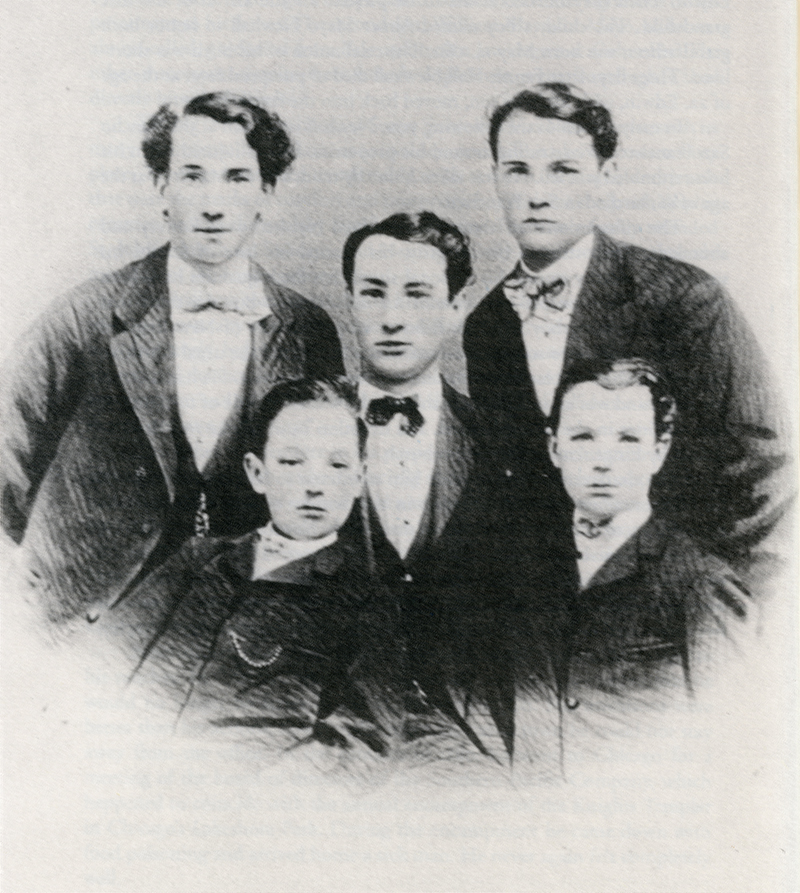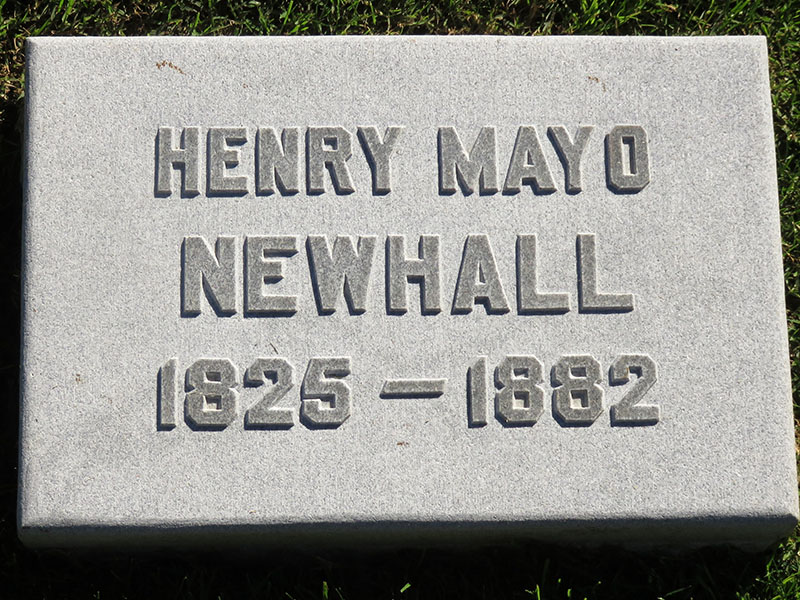|
|
The Newhall Land & Farming Co.

Click image to enlarge Henry Mayo Newhall's five sons, photographed in 1873. Eldest son Henry Gregory, then 20, is surrounded by (clockwise from upper left) William Mayo, 19; Edwin, 17; George, 11; and Walter, 13. All were at least 21 years old when they incorporated The Newhall Land and Farming Co. in 1883, with a stated capital of 10,000 shares at $100 per share. Henry Mayo's widow Margaret received 2,500 shares, while each of the five boys received 1,500 shares. The company owned 143,000 acres of California ranch land including about 48,000 acres in the Santa Clarita Valley.
Born May 13, 1825 in the industrial town of Saugus, Massachusetts, Henry Mayo Newhall sought his fortune in the California Gold Rush of 1849. He failed as a miner but succeeded as an auctioneer in brawling San Francisco. A keen businessman and shrewd investor, Newhall parlayed his auctioneering fortune into an even greater fortune in railroads, ultimately becoming one of the founders of the Southern Pacific Railroad Company. Between 1872 and 1875, Newhall purchased five of the old Mexican land grant ranchos throughout California, including 46,460 acres of the 48,000-acre Rancho San Francisco, covering the western half of the Santa Clarita Valley and eastern Ventura County. He sold a railroad right-of-way to Southern Pacific for a dollar and a plot of land for another dollar, and a town sprang up bearing his name. Two miles to the north, a second town bore the name of his birthplace. The Rancho San Francisco was used for farming and ranching during Newhall's lifetime. Newhall experimented with a wide variety of crops, from corn and alfalfa to sugar cane and citrus fruits. The staple, however, was wheat, which was harvested with great success until the early 1880s, when the climate changed for the worse. Newhall split his time between San Francisco, where he tended to the business of his H.M. Newhall & Co. auction house, and the Rancho San Francisco, where he planned to focus his attention after 1880. In the summer of 1880, however, while attending a Knights Templar event in an encampment in Chicago he contracted malaria, which took the form of blood poisoning. He was never quite the same again. In March of 1882, he was thrown from his horse while riding on the Rancho and fell ill from the virus in poison oak. He was taken by train to San Francisco and diagnosed with erysipelas, from which he died on March 13 at the age of 56. On June 1, 1883, H.M. Newhall's five sons incorporated the family-owned Newhall Land and Farming Company. Agriculture and cattle ranching, and vineyards in Central California, remained the company's focus well into the 20th Century, even after oil was discovered on the Rancho San Francisco (by now called the Newhall Ranch) in December of 1936. In the mid-1950s, however, change came very rapidly as the company went public and its directors took note of America's great westward migration. The New Town of Valencia — designed as a self-contained community where home, employment, schools, recreation, shopping and the outdoors interrelate — was born in 1965 and was still growing thirty years later. Citrus orchards and vineyards continue to produce revenue for the company, but housing is by far its biggest concern today as The Newhall Land and Farming Company develops New Towns in California and Arizona. Information from "A California Legend: The Newhall Land and Farming Company" by Ruth Waldo Newhall (1992).
RN7301: 9600 dpi jpeg from printed photograph in Ruth Newhall's &A California Legend.& |
H.M.N. CATEGORIES:
Documentary: Story of Henry Mayo Newhall & Newhall Foundation (2015)
Portrait x2
HMN Signature on SF&SJRR Pass, <1870
HMN's Railroad Receipts (2)
5 Sons 1873
Obituary 1882
Reading of Will 1882
Graves of HMN & Heirs, Wyatt Earp, more
Son H.G. Newhall's California Bank
Grandsons George A., Walter Scott 1912
Grandson Almer Calls Argentina 1930
|
The site owner makes no assertions as to ownership of any original copyrights to digitized images. However, these images are intended for Personal or Research use only. Any other kind of use, including but not limited to commercial or scholarly publication in any medium or format, public exhibition, or use online or in a web site, may be subject to additional restrictions including but not limited to the copyrights held by parties other than the site owner. USERS ARE SOLELY RESPONSIBLE for determining the existence of such rights and for obtaining any permissions and/or paying associated fees necessary for the proposed use.










